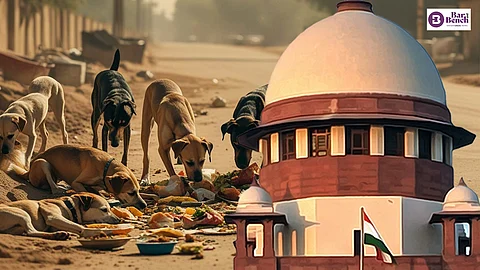Delhi stray dogs order: Polycentric problem, questionable process
On July 28, the Supreme Court of India, acting on a newspaper report, took suo motu cognisance of the rising incidents of stray dog bites in Delhi and the surrounding National Capital Region. The report, the Court observed, contained “extremely troubling details” – hundreds of dog bite cases, rabies infections and a disproportionate impact on infants and senior citizens.
Less than two weeks later, on August 11, the Court passed an order with far-reaching consequences. Amongst other things, it directed the Delhi government, the municipal bodies of Delhi and authorities in Noida, Ghaziabad, Gurugram and Faridabad to immediately begin picking up stray dogs from all localities and detaining them in dog shelters to be built within eight weeks. These shelters, according to the order, would sterilise, vaccinate and permanently house the dogs. None were to be released under any circumstances. A helpline was to be set up within one week and any complaint of a dog bite would trigger the capture of the animal within four hours. Any resistance to this exercise would be met with “the strictest of actions,” including contempt proceedings.
The gravity of the problem is undeniable. Rabies is a fatal disease; stray dog attacks, especially on children, are deeply disturbing. The question is not whether the problem warrants attention - it certainly does - but whether the way the Court has chosen to address it is institutionally sound and procedurally proper. On both counts, the answer is concerning.
A polycentric problem
The first difficulty lies in the nature of the dispute. The stray dog issue is polycentric. As Lon Fuller once described through his “spider’s web” analogy, in such problems, touching one strand sets in motion vibrations across the whole web. Here, the strands include the fundamental rights of humans to life and safety, the constitutional and statutory protections for animals, the capacity and budget of municipal bodies, the practicalities of building and maintaining shelters and the long-term public health implications of altering animal control practices.
These are not matters that lend themselves to quick, unilateral judicial solutions. They require careful sequencing of decisions, meaningful engagement with stakeholders and coordination across multiple layers of government and civil society. We have seen before how judicial interventions in polycentric matters have produced consequences, some of them unintended, because the complexity of implementation was underestimated. For instance, when the Court ordered a switch to CNG buses in Delhi through judicial fiat, without legislative deliberation or effective public consultation, concerns were raised over CNG’s untested nature, lack of infrastructure, infeasible timelines and the financial distress such a shift caused to government bodies. The current directions on stray dogs risk falling into the same trap.
Procedural impropriety
Second, the Court’s own process sits uneasily with its assertion that the order was the result of the “deepest of deliberation” rather than “momentary impulse.” The record shows that suo motu cognisance was taken on July 28 and the interim substantive order passed on August 11 – a timeline hardly compatible with the complexity of the issues involved.
More importantly, the Court explicitly declined to hear intervention applications from those who might have been concerned towards the cause. In its own words:
“Since this is an ongoing exercise, we are not, at this stage, inclined to entertain any intervention applications…Once these relevant details are placed…we will take into consideration the intervention applications…on their own merits.”
The problem with this approach is obvious. By deciding the key question first (albeit temporarily) and only then agreeing to hear from other stakeholders, the Court has inverted the principles of natural justice. Affected parties are entitled to be heard before the decision is made, not after.
Procedural fairness is not a technical nicety. It is a core component of the rule of law. When the Court itself bypasses these safeguards, the legitimacy of its orders suffers, no matter how well-intentioned the outcome.
Misapplication of the law
Third, the directions appear to rewrite the governing statutory framework. The Animal Birth Control Rules, 2023, framed under the Prevention of Cruelty to Animals Act, 1960, provide that captured stray dogs must be sterilised, vaccinated and released at the same place from where they were picked up. This provision is not incidental; it reflects a considered policy choice, grounded in animal welfare principles, that permanent detention is neither humane nor effective in controlling stray populations.
The Court’s order to detain all stray dogs indefinitely “under no circumstances” releasing them reverses this legislative mandate. Further, the Court’s observation that the 2023 Rules “perpetuate infringement” of human fundamental rights is a serious claim, but it is one that requires full argument and careful reasoning before the Court can simply set aside the statutory scheme.
Why procedure matters
It is important to be clear: this is not an argument against tackling the stray dog menace. It is an argument against doing so in a way that ignores process, bypasses affected voices and collapses complex, interlocking considerations into a single judicial command. When the Court moves too quickly in such matters, it risks overstepping its institutional role, creating orders that are difficult or impossible to implement, and undermining public confidence in its own procedures.
Swapnil Tripathi leads Charkha, the Constitutional Law Centre at the Vidhi Centre for Legal Policy. Views are personal.

